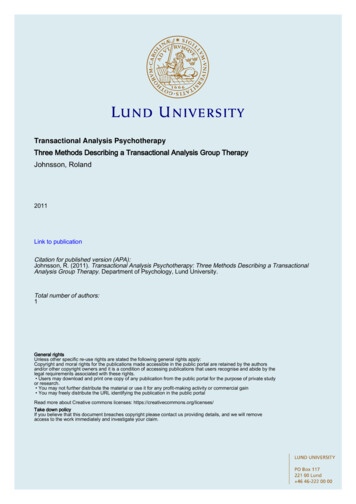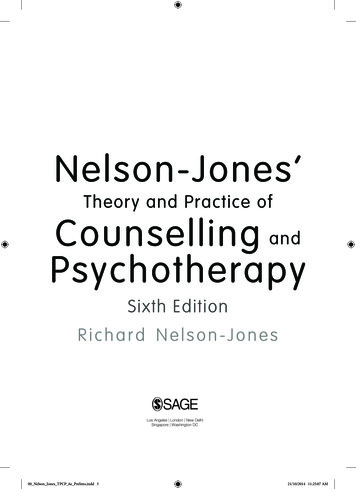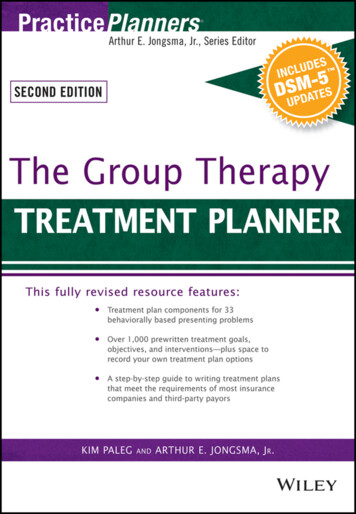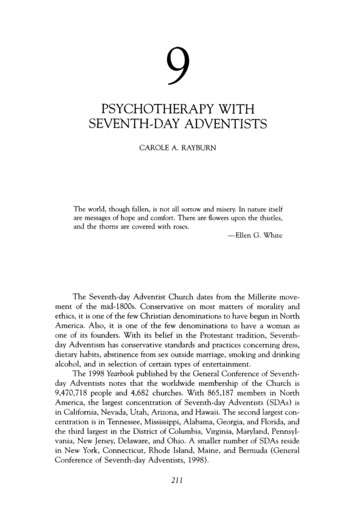
Transcription
PSYCHOTHERAPY WITHSEVENTH0DAY ADVENTISTSCAROLE A. RAYBURNThe world, though fallen, is not all sorrow and misery. In nature itselfare messages of hope and comfort. There are flowers upon the thistles,and the thorns are covered with roses.-Ellen G. WhiteThe Seventh-day Adventist Church dates from the Millerite movement of the mid-1800s. Conservative on most matters of morality andethics, it is one of the few Christian denominations to have begun in NorthAmerica. Also, it is one of the few denominations to have a woman asone of its founders. With its belief in the Protestant tradition, Seventhday Adventism has conservative standards and practices concerning dress,dietary habits, abstinence from sex outside marriage, smoking and drinkingalcohol, and in selection of certain types of entertainment.The 1998 Yearbook published by the General Conference of Seventhday Adventists notes that the worldwide membership of the Church is9,470,718 people and 4,682 churches. With 865,187 members in NorthAmerica, the largest concentration of Seventh-day Adventists (SDAs) isin California, Nevada, Utah, Arizona, and Hawaii. The second largest concentration is in Tennessee, Mississippi, Alabama, Georgia, and Florida, andthe third largest in the District of Columbia, Virginia, Maryland, Pennsylvania, New Jersey, Delaware, and Ohio. A smaller number of SDAs residein New York, Connecticut, Rhode Island, Maine, and Bermuda (GeneralConference of Seventh-day Adventists, 1998).21 1
The world conference of Seventh-day Adventists, the General Conference, is in Silver Spring, Maryland. The General Conference presidentmeets with and advises church leaders from the 12 divisions of the Church(such as the North American Division), unions (made up of conferencesor fields within a larger territory), and local conferences (comprised ofchurches within various cities). Traditionally, the Church governance hasbeen male-dominated and male-controlled (C. S. Rochester, personal communication, June 26, 1998).The SDA Church has an extensive educational system consisting ofhundreds of elementary and secondary schools, as well as many collegesand universities throughout the world. There are 10 colleges and universities in the United States. The extensive hospital system, better knownoutside of North America, includes every facet of health care. Loma LindaUniversity Medical Center, in California, has gained worldwide prominence in medical research and treatment. Andrews University, in BerrienSprings, Michigan, boasts the major theological seminary for SDAs.BELIEFS AND TRADITIONSMillerism and Its InfluenceWilliam Miller, a Protestant preacher of the mid-l800s, taught thatChrist would soon be returning in regal glory to claim those who believedin him and take them to their heavenly abode for 1,000 years. This wasto occur on a specific day and year. Members of the Millerite group soldall of their earthly possessions in preparation for their relocation to heaven.The 1,000-year period described in the Book of Revelation involves thebattle between Jesus and Satan, the defeat of Satan and thus of evil, thedestruction of the world, and its purification and rehabilitation by thefaithful.Because the end of the world predicted by William Miller did notcome about, the Millerites had to do much prayerful rethinking. Theydecided that the specific date predicted by Miller was actually the timethat Jesus as Priest of the heavenly temple entered the temple to go overthe Book of Life. Ellen G. White, then a member of the Methodist Church,began prophesying and writing prolifically to elucidate scriptural writings.SDAs regard such a corpus of literature not as new scripture but as commentary on scripture (though some non-SDA writers have misinterpretedthis position). Ellen G. White is regarded by most SDAs not only as afounding pioneer of the SDA Church but as a prophet of Seventh-dayAdventism.212CAROLE A . RAYBURN
Seventh-day Sabbath ObservanceThe Millerites ultimately became known as Adventists because theyanticipated that Christ would soon come again. However, it was not untilanother Methodist woman, Rachel Oakes Preston, became interested inthe seventh-day sabbath that emphasis on sabbath observance on the seventh day was brought into the Adventist Church. Preston became aSeventh-day Baptist, and she finally was successful in convincing Adventists of the importance of observing the sabbath on the seventh day ratherthan on the first day of the week. (First-day Adventists, also influenced byMiller, worship on Sunday.) Thus, the denomination became known asSeventh-day Adventism: anticipation of the advent of Christ and worshipon the seventh day being the two most prominent distinctions for SDAs.The sabbath is set aside for worship activities from sundown Fridayto sundown Saturday. During this time, there is a prohibition against working and against “buying and selling” (exchanging money or bartering othergoods); church members also refrain from “doing one’s own pleasure”(which has been interpreted in a variety of ways). Medical work, however,is an exception, because this may involve life and death issues or at leastvery urgent health concerns. David Reile (1997) noted that what is considered to be acceptable for sabbath observance varies significantly fromone individual to another and may seem inconsistent or contradictorywithin the belief system of one individual.Gift of the Spirit of ProphecySeventh-day Adventists believe in the gift of prophecy in postbiblical times, as described in scripture, particularly as this is associatedwith the last days of earth before the Second Coming of Christ. Ellen G.White is considered to have been such a prophet, as her visions aboutreligious and spiritual matters provided guidance to the newly formed Adventist Church. Many believers have taken these visions and White’s writings as being truth for the latter days of the church of Christ.State of the DeadSDAs believe that the dead know nothing but are in a state of “sleep”until they are awakened at the Second Coming of Christ. The righteousdead will be resurrected to immortality; the unrighteous dead will returnto life temporarily with the same diseases and corruption that they had atthe time of the first death. These unrighteous will die a second death andbe completely destroyed after the battle between good and evil.SEVENTH-DAY ADVENTISTS213
Baptism by ImmersionSDAs dedicate infants in a church ceremony by a blessing and layingon of hands. Generally, only adolescents and adults are baptized, however.This symbolic going down to a watery grave with Christ and rising withthe victorious Lord are carried out by immersion in a baptistry or a bodyof water. Pouring and sprinkling cannot substitute for immersion.TithingMany SDAs give the Church one tenth of their earnings before theydeduct anything for their expenses. This money is considered to be God’smoney. There has been a dispute by some ethnic minority SDAs becauseproportionately they give more money to the Church than ethnic majoritymembers, but they get less back when the Church redistributes the funds.Tithing is given in addition to contributions to be used in the local church.Healthful Living and Modest DressAbstaining from alcohol and other drugs and not smoking, maintaining a kosher or even a vegetarian diet, getting adequate sleep and rest, andexercising regularly are espoused by the Church for keeping the bodythe temple of God-pure,holy, and healthy. Modesty in dress is alsotaught, because use of jewelry (often including wedding rings) and veryelaborate clothing is held to be worldly, wasteful, and ungodly. The wearingof cosmetics is also frowned upon by very conservative SDAs. Bringingattention to oneself is not viewed as good or wise. However, these restrictions are gradually declining; using cosmetics tastefully and wearing wedding bands (especially by non-North American SDAs) are more widelyacceptable now, as is wearing pins and some semiprecious stones. Thesedifferences reflect generational and geographical variations. For instance,the West Coast and the East Coast of the United States may differ in theways in which SDAs live their faith. Reile (1997) has observed that someyounger and new SDAs may accept moderate drinking. Case (1996a), ina very large study of SDAs, commented that there is a trend of increasedwine usage by younger Adventist adults: SDAs over 65 years of age havea ratio of 1 in 20 who used wine, whereas those 18-29 years of age havea ratio of 1 in 4 who have used wine.Prohibition Against DancingAny type of dancing, even square dancing, is viewed by many SDAsas unacceptable and sinful, especially among older and non-North American SDAs. This prohibition is based on the belief that improper sexual21 4CAROLE A. RAYBURN
intimacy for a couple and even married couples may occur while theyengage in dancing. Although less of a concern among younger SDAs, forolder members (over 60 years of age) and for those in conservative regions,the belief may still be strong. In the Value-Genesis Study of the SDAs,Dudley (1992) reported that 58% of the SDA youths in Grades 6-12disagreed with the Church standard on dancing.Avoidance of Movies, Theaters, Nightclubs, and C'ircusesThis is the belief that any form of entertainment might distract in-dividuals from the strictly spiritual pursuits of Bible study and church activities. Although this belief is still held by many conservative SDAs, it isbeginning to lessen among the more liberal and younger members. SDAshave performances of plays such as The Diary of Anne Frank in their schoolsand Barbra Streisand movies such as What's Up, Doc? at Andrews University, the university that houses the only full seminary in Seventh-dayAdventism. In Berrien Springs, Michigan, the home of the seminary, moreliberal SDA teachers and professors, the university bookstores, and filmprograms often lean more toward liberal thinking. However, Takoma Park,Maryland, former home of the General Conference and local conference,has far more conservative members in general. Nonetheless, the main SDAbookstore in Takoma Park now sells items of jewelry, such as religious pinsand refrigerator magnets of angels. Initially, conservatives frowned uponanything that would present a vaudeville or circus thrill, tempting thesaints of God from their first love: reflecting the love and spirit of JesusChrist to other believers and to the world.Case ( 1 9 9 6 )found that, although the SDA Church maintains itsofficial stance against movies, most SDAs watch movies regularly in theaters and in their homes and that they may even go to movies more oftenthan do their secular counterparts. He suggested that values related tocentral SDA theological issues may be believed and well-kept, whereasthose reflecting more popular culture tend to be less maintained. Dudley(1992) found that 64% of SDA youths disagreed with the Church standardon attending movies in theaters. Furthermore, 55% of these youths disagreed with the Church about listening to rock music.Avoidance of Premarital Sexual IntimacyAlthough not necessarily observed by all SDAs, strict sexual abstinance before marriage is observed by conservative members. Indeed, notonly sexual intimacy but excessive masturbation (any masturbation for conservative members), pornography, and obsessions about sexual activitiesmight be deemed sinful and unacceptable. Knott (1996) reported thatyouths in SDA schools are far less likely to be involved in sexual practices.SEVENTH-DAY ADVENTlSTS215
Dudley (1992) found that two thirds of SDA students in Grades 6-12agreed with their Church’s standards on sexual morality, but 18% (almostone fifth) disagreed on this, and 14% was not sure; SDA youth, surroundedby the cultural sexual revolution, may be turning away from the SDAtraditional ideal of sexual purity. Corea (1996), studying the nonvirginstatus of SDA youth, reported an increase in sexual activity with increasingage and, among those who indicated that they were not virgins, there wasa higher percentage in the SDA group than in “mainstream Protestantchurches” of those who had been sexually intimate before marriage.Ordinance of Humility (Foot Washing)The Ordinance of Humility or Foot Washing was mentioned in theOld Testament as a rite of hospitality and in the New Testament as anordinance done just before the feast of Passover. Jesus washed the feet ofthe disciples and instructed them to wash each other’s feet. A woman isdescribed in all four Gospels as washing Jesus’ feet. SDAs believe that thisordinance teaches people to come into a holy union with one another andto help and bless one another. It is not intended as anything degrading,but rather it is a demonstration of kindness and tenderness toward oneanother.Ellen G. White spoke of the biblical example of women washing malebelievers’ feet, but not of brethren washing women’s feet (White, 1882).In practice, however, pairs of same-gender individuals wash each other’sfeet before the service of the Lord’s Supper. In the more conservative SDAchurches, even husbands and wives may not wash each other’s feet. Thejustification given for this segregation is that it would be immodest forwomen to take off their stockings in front of men or for men to have tokneel before a woman’s skirt or undergarments (Rayburn, 1993).The TrinityThe Trinity is a basic belief of the SDA Church. There is one God,a unity of three coeternal persons of the Godhead: “God the Father, Son,and Holy Spirit.” For a fuller overview of this and other SDA beliefs, pleaserefer to the “Fundamental Beliefs of Seventh-day Adventists” (GeneralConference, 1998).Unity in the Body of Christ and the Role of WomenOne of the fundamental beliefs of SDA is the unity in the body ofChrist: The Church is one body with many members, a new creation transcending distinctions of culture, gender, ethnic identity, nationality, edu21 6CAROLE A. RAYBURN
cation, and socioeconomic level. All people are equal in Christ; SDAs areto serve and to be served without reservation or partiality.There is a growing concern and displeasure among some SDAs, particularly some women, who do not believe that the traditional role ofwomen in the SDA Church reflects such unity in the body of Christ. Thisis especially painful to some SDA women in light of the vital roles thatwomen such as Ellen G. White and Rachel Oakes Preston played in thedevelopment of the Seventh-day Adventist Church. Furthermore, womensuch as Charlotte Elizabeth Poor and Harriet Livermore were of crucialimportance to the Millerite and Adventist movements, writing significantreligious literature. Some SDAs do not think that women of more currenttimes have been given responsibilities and leadership positions commensurate with those of men. During the Millerite movement, women weremore concerned about religious issues on average than were men, andwomen played important roles in public and in private (Rayburn, 199710).Today, educational pursuits are encouraged for all SDAs, and manyroles outside the ecclesiastical structure are open to women. Nonetheless,women are denied full participation within the governance of the Churchitself. In fact, for the most part, women who have limited ministerial rolesare not even called minister or pastor but rather associates in pastoral care.They do not have the professional status of clergy, nor do they receive thesalary and other clerical job opportunities that male clergy do. The effectof such limitations for preaching, administering, and performing the sacredroles in the Church is sweeping. Girls and women have no adequate femaleecclesiastic role models at the highest level of participation. Men as wellas women may need to choose between their dreams of equality and sharedroles in the Church and the reality of a church with male dominance andcontrol (Rayburn, Natale, 6r Linzer, 1982).The importance of the role of girls and women is one to which bothSDAs themselves and therapists who work with SDAs should not takelightly nor dismiss as tangential to the SDA faith experience as it is livedin everyday existence. Adventist writers such as Gillespie (1996) and Dudley (1992) have shown laudable sensitivity to this grave concern. They areconcerned that denying women an ordained ministerial role may lead to aschism and to people leaving the SDA Church. Speaking of values concerning women and social justice, Dudley sees the role of women in ministry as one of the most widely debated current issues in the SDA Church.Young people are as badly split on this issue as their parents and churchleaders, with 54% somewhat or strongly favoring having women ordainedas local church elders, 47% favoring having women pastors, and 42% favoring having women ordained as pastors in the SDA Church governance(not just limited to the local church). No gender differences were reportedby Dudley. Furthermore, loving and serving other people was weakly relatedto favoring women in ministry.SEVENTH-DAY ADVENTISTS21 7
THE SDA POSITION ON IMPORTANT SOCIALAND MORAL ISSUESDivorce and RemarriageThe SDA position is that divorce is not part of God’s plan. However,the Church recognizes that in the current day, with its problems of disobedience toward God and disrespect for self, others, and God, divorce willoccur. The most accepted reason to allow divorce is adultery. In practice,one person is usually considered to be primarily responsible for the dissolution of the marriage, with the other seen as being relatively innocent.Both the divine and civil aspects of divorce are recognized by the Church.Remarriage is also not looked upon as God’s plan. Marriage is notdissolved except for infidelity, adultery, and fornication (including a homosexual partner). The estate of marriage has both divine and civil aspects.According to the church discipline, individuals have no right to remarryif the “innocent” party is living, unmarried, and chaste. Should the noninnocent person remarry before the innocent partner, the noninnocentindividual would most likely be disfellowshipped by the Church.Birth ControlThe SDA Church supports birth control through the methods of abstinence, protective devices, and birth control pills. Abortion is not anapproved method of birth control.AbortionSeventh-day Adventists believe that all life is sacred. Abortion forgender selection, birth control, or convenience is not condoned. Nonetheless, in cases of rape, incest, or danger to the health of the woman,abortion can be condoned. Thus, there is a limited, conservative positionon prochoice, but a predominant position held by the Church authoritiessupports probirth or prolife. This position of probirth, however, is not unilaterally supported by all SDA women and men.HomosexualityThe official position of the denomination on homosexuality is thatthe behavior and lifestyle are not condoned, but the homosexual person is218CAROLE A. RAYBURN
to be loved and accepted. This acceptance is encouraged with the goal ofchanging the gay men and lesbians, however. There is a serious questionof whether a person is allowed to be SDA and gay. This is not a positionheld by all SDAs, however.Corporal PunishmentIn disciplining children, the SDA position accepts spanking a childwithin reason: A very mild application of the biblical injunction, “Sparethe rod, spoil the child.” Certainly, no abusive situation would be acceptable (C. s. Rochester, personal communication, June 26, 1998).While attending seminary for a Master of Divinity degree, I was calledupon to give counsel on a matter involving a minister who was also attending the seminary. The minister disciplined his children harshly by beating them when they disobeyed him. He was warned by church and seminary authorities to discontinue such behavior. He excused himself, sayingthat he was from the West Indies, and that this form of discipline was acultural matter. Nonetheless, he was instructed that such behavior wouldnot be permitted in North America. Church leaders required him to acceptcounseling and to stop this maltreatment of his family. He appeared tocomply with this requirement, and counseling was also arranged for thechildren and their mother.IMPLICATIONS AND GUIDELINES FOR COUNSELINGAND PSYCHOTHERAPYEllen G. White’s Guidelines to Mental and Spiritual HealthEllen G. White, a founder and the recognized prophet of the Seventhday Adventist Church, addressed matters of character, mind, and personality in many of her writings. These writings were much later put in acompilation, Mind, Chructer, and Personality: Guidelines to Mental and Spiritual Health (White, 1977). Some older and many conservative SDAs maybe influenced by White’s early comments on Satan’s being able to workthrough the sciences, including psychology, phrenology, and mesmerismpsychology, to influence the mind. Her fear was that mind control couldbe used to delude unsuspecting Christians. White’s primary message herewas that only through complete dependence upon Christ might peopleescape the snare of deception and evil. She warned others that, in the lastdays, Satan would work unceasingly to bring fanaticism among even SDAsand thus to bring extreme criticism and harsh treatment from the worldSEVENTH-DAY ADVENTISTS219
on SDAs. Her remedy for dealing with the fanatical mind, with its unreasoning zeal, dazed self-importance, excessive pride, and combative ways,was to rely on Christ only and not on one’s own strength, not enter intocontroversy with the fanatic but to affirm everything about God with “Itis written” and “Thus saith the Lord” (White, 1915). To White, mindcontrol was a form of fanaticism. On the other hand, a healthy normalmind involved neither cold orthodoxy nor careless liberalism (White,1977).White urged that people control their impulses and emotions or, atleast, control their will; this strength comes only from God. Feelings areoften deceiving. A t times, the Lord may disturb the mind with feelings ofunrest or loneliness to teach dependence on God and turn people’s attention to eternal realities. She warned of the danger of becoming selfabsorbed in self-study or emotions, but taking problems to God and occasionally to a pastor-counselor was urged.Guilt or a sense of sinfulness put clamps on a truly happy life. Repentance, confession of sins, and true humiliation in asking God’s forgiveness for the sin, along with true forsaking of the sin, is needed to get theperson back on the path to a sanctified and productive life. Worry killsand brings on unrest and anxiety. She urged that worries be taken to Godand that people take each day at a time (“Sufficient unto the day is theevil thereof,” Matthew 6:34). “Let us not make ourselves miserable overtomorrow’s burdens” was White’s strong recommendation (White, 1902).Faith dispels anxiety (White, 1905).Seeing the connection between mind and body functions, White(1891) wrote, “Those who are sick in body are nearly always sick in soul,and when the soul is sick, the body is made sick.” In counsel that wouldagree with much modern feminist therapy, White wrote in 1900 (White,1977) that counselors can help those who have erred by telling them ofthe counselor’s experiences to show how others gave the erring personcourage and hope by expressions of patience, kindness, and helpfulness.She instructed people not to talk of negative feelings lest they discourageboth themselves and others (White, 1905). Although this might initiallybe viewed as a form of denial of one’s feelings, it is more a power of positivethinking, 2 la Norman Vincent Peale. In her most widely read book, Stepsto Christ, White wrote in 1892, “Jesus did not suppress one word of truth,but he uttered it always in love.”White (1880) wrote in a patriarchal structure of her times that acounselor be a man of sound judgment and undeviating principle, a personof moral influence who knows how to deal with minds, who possesseswisdom, culture, affection, and intelligence. Gentleness and unbending integrity in a counselor are needed to contend with prejudice, bigotry, anderror of every form and description. A kindly approach without reproachis needed, with no blame or condemnation in coming close to a troubled220CAROLE A. RAYBURN
person’s side to help him or her. Yet, in counsel to a minister (White,1889a, 1977), she cautioned that private counseling on private mattersconcerning either families or individuals can become a snare for both thepastor and those counseled because people might turn in their dependenceon another person and not on God. In 1915, she wrote that the work ofthe pastor-counselor is more important than that of the physician in dealing with sin-sick souls: Eternal life is more valuable than temporal existence.Counselor-Client RelationshipCounselors and psychotherapists who are SDA themselves or who seeSDA clients and patients have often reported being distrusted by older andmore conservative SDAs concerning psychology, psychotherapy, and psychiatry. These individuals may experience difficulty in perceiving that anyone can be both a psychologist and a believer or a therapist and a Christian. Barbara Suddarth (personal communication, November 2, 1997), afifth-generation SDA and a counseling psychologist, found such distrustcurious in an organization that places much importance on health care butseems to overlook mental health, at least for more conservative members.Some may fear that psychotherapy will involve mind control, brainwashing, or hypnosis. Some more conservative SDAs may suspect psychotherapists and counselors who were not trained in SDA graduate schools orwho are not “Christian counselors” (which would imply a specialty inChristian counseling). Because some SDAs may be very critical of themselves and of others, they usually respond well to a psychotherapeutic approach that is nonjudgmental.Reile (1997) pointed out that SDAs are similar in many ways to“mainstream” conservative Christians: Usually fervent believers in prayer,they may fear that seeking mental health remedies would suggest that theydoubt God’s power to overcome problems and show their lack of faith andgood prayer life. As with all religious clients, therapists must support theclient’s belief system at least initially and not challenge or label it (e.g.,magical thinking). Because new clients may think that psychology andpsychotherapy involve Freudian “obsession with sexuality,” hypnotizingpeople to do something against their will, and invasion into the moreprivate facets of their lives, they need to hear from the therapist at theoutset what type of therapy will be practiced and what results might beanticipated. Therapists need to recognize that there are many individualdifferences among SDAs and that SDA beliefs different from their own donot usually indicate bizarre or unhealthy conditions (R. Proctor, personalcommunication, September 2, 1997).SEVENTH-DAYADVENTISTS22 1
Assessment and Diagnostic IssuesSDAs may be very selective as to which assessment tool they willtolerate. For instance, they may not react well to the Minnesota Multiphasic Personality Inventory if they interpret it as being unsympathetictoward religious persons. The same may be true of the Thematic Apperception Test. The therapist may be able to use these instruments with moreliberal SDAs, however. The more projective tools, such as the HouseTree-Person, Human Figure Drawings, Draw-A-Person-in-the-Rain, Kinetic Family Drawing, Self-Image Drawing, Sentence Completion, andRorschach Inkblot Test may be seen as being safer by most SDA patientsand clients. Also, they might be assessed with the Faith Maturity Scale(Benson, Donahue, 6r Erickson, 1993) and with other religiousness andspirituality measures, such as the Inventory on Religiousness (Rayburn,1997a) and the Inventory on Spirituality (Rayburn & Richmond, 1997).John Berecz (1998), a clinical psychologist in both private practiceand academia, sees working with SDA clients as a unique experience inmulticulturalism. He has found differences among SDAs to be as great asdifferences between Adventists and United Methodists. Berecz views California Adventists as being rather wry and stereotypical liberals and intellectuals who believe in the full equality of women, favor the ordination ofwomen to the gospel ministry, and consider sexuality to be part of humanfunctioning in both the procreational and recreational senses. Furthermore,California SDAs are generally more trusting of psychology and psychotherapy than SDAs from other regions of the United States. A t the opposite pole, Berecz described Third World Adventists as insisting on thepatriarchal view of the male person as the biblically ordained priest of thehome, with the wife created to be subservient and to function as a helperto her husband; these SDAs think that sexuality is a very private matter,primarily for procreation. They do not think that women should ever function as ordained ministers or have equal rights.Frederick Kosinski, Jr. (personal communication, January 3, 1998), acounseling psychologist in private practice and academia, notes that halfof his clients are SDAs, ex-SDAs, or have been part of the SDA community. Having worked in several states in North America, he has observedthat rather conservative SDAs in western Nebraska nonetheless ate beefand drank bitter black coffee. At an SDA college in Lincoln, Nebraska,however, the SDAs were more liberal. Michigan SDAs were more conservative than California SDAs but more liberal than SDAs in Nebraska,Maryland, or the District of Columbia. SDAs living around large Adventistinstitutions may be more conservative than those who work for those institutions and less conservative than SDAs living in small communities.SDAs seem to exist on a continuum, with most being centrist or moderate.It is important for therapists to determine what kind of Adventist an in-222CAROLE A. RAYBURN
dividual is, what the person believes, and how these beliefs affect and shapethe
-Ellen G. White The Seventh-day Adventist Church dates from the Millerite move- ment of the mid-1800s. Conservative on most matters of morality and ethics, it is one of the few Christian denominations to have begun in North America. Also, it is one of the
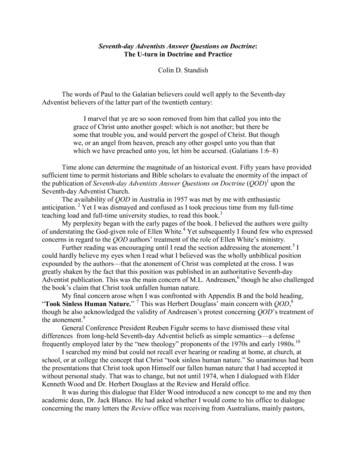
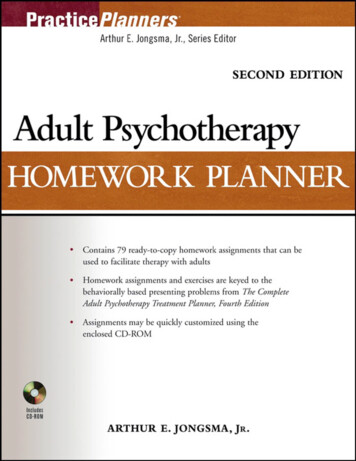
![Welcome [dashdiet.me]](/img/17/30-day-weight-loss-journal.jpg)



